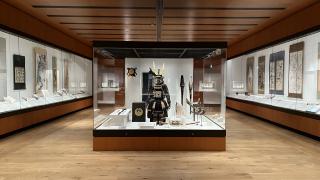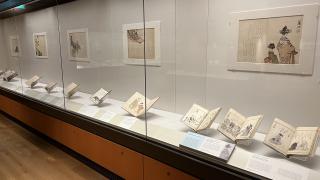国際共同研究プロジェクト「上方文化サロン:人的ネットワークから解き明かす文化創造空間 1780-1880」の研究成果を大英博物館で特別展示
この度、イギリス・ロンドンにある大英博物館では、日本学術振興会(JSPS)および英国研究・イノベーション機構(UK Research and Innovation, UKRI)の助成による国際共同研究プロジェクト「上方文化サロン:人的ネットワークから解き明かす文化創造空間 1780-1880」の研究成果を紹介する1年間の特別展示が開催されています。
立命館大学アート・リサーチセンター(ARC)センター長の赤間亮教授と大英博物館アジア部学芸員の矢野明子博士を研究代表者とするこの研究プロジェクトは、大英博物館、そして日本各地に所蔵されている5,000点を超える作品を分析することで、前近代日本、特に1780年から1880年頃の京阪神地域で発達した“上方文化サロン”や文化創生における集団制作(合作)システムの文化的・社会的影響を調査・分析し、高度な文化成熟が成立するメカニズムを解明することを目的としています。
本プロジェクトでは、ARCが構築・運営するオンライン型研究システム「上方文化人総合データベース」に、これらの作品を登載しました。このシステムは、研究活動に活用できる前近代日本文化研究の新たなポータルとして、複数のデータベースにより構成されています。将来的に同様の形で異なるテーマのポータルを追加することも可能です。
→ARCバーチャル・インスティテュート:「上方文化サロンとネットワーク 1780年~1880年」
COVID-19の課題に取り組むこのプロジェクトは、立命館大学アート・リサーチセンター、関西大学、京都国立近代美術館、大英博物館、ロンドン大学東洋アフリカ研究院(SOAS)の研究者チームから構成され、オンライン・デジタル技術を駆使した日英共同研究の効率的な進め方の模範となっています。
また本プロジェクトは、国際的な研究環境の中で日英の若手研究者にデジタル・ヒューマニティーズの基礎を学ぶ機会を提供し、日本研究の若手研究者育成に貢献しました。
本研究は、日本学術振興会国際共同研究事業英国との国際共同研究プログラム(JRP-LEAD with UKRI)[課題番号JPJSJRP 20211708]による支援を受けたものです。
実施期間: 2021年12月1日~2024年11月30日(3年間)
関連記事:https://www.britishmuseum.org/research/projects/making-art-together-japan
[Official release from the British Museum]
Special display
City Life and Salon Culture in Kyoto and Osaka, 1770-1900
Rooms 93 and 94, Mitsubishi Corporation Japanese Galleries (free admission)
First rotation: 6 April 2024 - 6 October 2024 (TBC)
Second rotation: 10 October 2024 (TBC) - March 2025
Kyoto and Osaka were two major cities in Japan during the Edo period (1603-1868). Kyoto was the imperial capital, while Osaka was the centre of domestic trade. The seat of the samurai government was in Edo (present-day Tokyo).
Education and the arts flourished in all three cities. New artistic styles, technology and science developed. These dynamic trends were stimulated not just through Japanese ingenuity, but also due to contact with the wider world via Nagasaki, the only international port during this time.
In these cities and beyond, people - both professional and amateur - came together to practise hobbies, from poetry, painting and music to gardening and tea ceremony. Within these cultural spaces, or 'salons', official class distinctions were set aside and people collaborated on equal terms. This ethos was the basis of cultural vibrancy across Japanese society from the late 1700s.
Despite Japan's political turmoil and change from the 1860s, the practice and spirit of 'salons' continued until at least the beginning of the 1900s.
This special display draws on the British Museum's rich and deep collection of Japanese art to uncover the lively energy of salon culture in Kyoto and Osaka. The display includes paintings, prints, books and beautifully crafted objects that reflect the latest artistic trends at the time and showcase contemporary Japanese people's delight in all forms of cultural activity.
Topics covered in the special display include:
Kyoto: the evolving ancient capital of Japan
Osaka: the centre of commerce and curious minds
Nagasaki: gateway to the outside world
Hobbies and collaborative artistic works
Popular forms of poetry and surimono
Bunjin: adoration of Chinese literati ideals
Sencha: tea as elegant pastime
This display is one of the outcomes of a three-year international research project exploring salon culture in Kyoto and Osaka, funded by UK Research and Innovation through the Economic and Social Science Research Council, and by the Japan Society for the Promotion of Science.
To coincide with the display, a richly illustrated publication, Salon culture in Japan: making art, 1750 to 1900, edited by Akiko Yano, will be published by the British Museum Press in June 2024. (Priced at £30)

